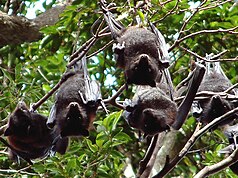Hope Islands National Park
| Hope Island National Park | ||
|---|---|---|
| Two-colored fruit pigeon ( Ducula bicolor ) | ||
|
|
||
| Location: | Queensland , Australia | |
| Specialty: | Sea birds | |
| Next city: | Cooktown | |
| Surface: | 84.3 ha | |
| Founding: | 1939 | |
| Black fruit bat ( Pteropus alecto ) | ||
The Hope Islands National Park (formerly Snapper Iceland and-Hope Islands National Park ) is a National Park in the Australian state of Queensland . It is 1,521 kilometers northwest of Brisbane .
location
The park consists of four islands: East Hope and West Hope Island, Snapper Island and Struck Island.
- The Hope Islands are about 37 kilometers southeast of Cooktown and 8 kilometers off the coast. These two islands lie on two separate reefs, which are separated from each other by a deep water zone.
- Struck Island is a rocky island off Thornton Beach, south of Cape Tribulation .
- Snapper Island is located at the mouth of the Daintree River and is about 2 kilometers long. This island is about 20 kilometers north of Port Douglas
Flora and fauna
While West Hope Island is an island thrown up from coral debris that is only sparsely covered with vegetation, East Hope Island is made up of finer soil materials that became more densely overgrown after it was stabilized.
Freshwater resources are lacking due to the soil conditions on West Hope Island. This is why the saltwater-friendly mangroves dominate here. On East Hope Island, however, the vegetation is more abundant.
The islands are u. a. The basis of life for over 25 sea bird species. West Hope Island is considered to be one of the most important seabird breeding areas in the entire Great Barrier Reef area . There are also colonies of the two-colored fruit pigeon ( Ducula bicolor ) and a colony of the black flying fox ( Pteropus alecto ) on East Hope Island .
tourism
There is no official, regular ferry connection to the islands. Camping on the island is severely restricted and requires good preparation and self-sufficiency.
history
The Hope Islands got their name from Captain James Cook after he ran aground in June 1770 with his ship Endeavor on the nearby reef, which is now called Endeavor Reef .
Long before that, the islands and the sea around them belonged to the tribal area of the Kuku Yalanji Aborigines who looked for food here.
Web links
- Official site of the park (English)
Individual evidence
- ↑ Australian Government - CAPAD 2010 ( MS Excel ; 170 kB), DSEWPaC , accessed on January 7, 2013 (English)
- ↑ Australian Government - CAPAD 1997 ( MS Excel ; 93 kB), DSEWPaC , accessed on January 7, 2013 (English)
- ↑ a b Explanatory Notes by the Queensland Government
- ↑ Queensland Government Notes on Wildlife
- ↑ Camping regulations in the national park


